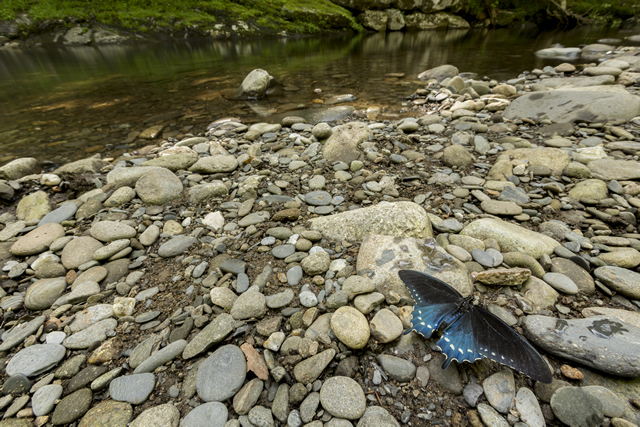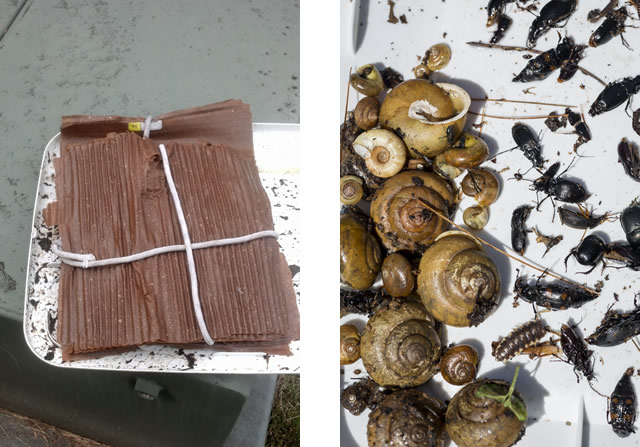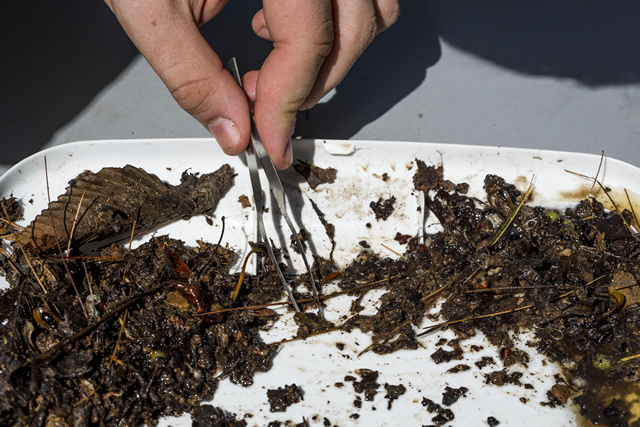Micah Jasny is a graduate student from the Nicholas School of the Environment at Duke University working this summer as an E.O. Wilson Biodiversity Foundation intern, as part of the ATBI/BioBlitz SWAT Team. His work is supported through a partnership with Discover Life in America. This summer he will try to discover new species to add to the park inventories in order to better understand park ecosystems and how to care for them. He also plans to help other scientists working in the park with their biodiversity surveys and scientific research. In the upcoming weeks, he will give weekly updates about his forays into the park and report back on his biodiversity research.
I am now entering the home stretch of my ATBI/BioBlitz SWAT Team internship and am happy to provide an update on my hunt for earwigs! In my last blog on the project, I was deploying earwig pitfall traps filled with a mixture of soy sauce and vegetable oil at five locations throughout the park. These traps have managed to ensnare a plethora of insects from snails and millipedes to assassin bugs and dung beetles. That being said, over the last couple of weeks I have made some interesting insights that have led to a change in strategy.
Video courtesy of Dan Mele Photography & Film
First, since pitfall traps are small open containers, if there is a large deluge of rain, they run the risk of being overfilled or washed-out by water and thus either lose their trapped occupants or lose the bait that was meant to attract the earwigs. Furthermore, while vegetable oil and soy sauce are not great attractants of megafauna, the traps are enough to pique some unwanted attention. I found a couple of sites where the plastic pitfall traps had been pulled out and either smashed or bitten. Because of these disturbances, I’ve had to stop sampling at these locations since we do not want whatever is messing with my traps to grow accustomed to feeding from human sources.


Photograph courtesy of Dan Mele Photography & Film
I have therefore decided to diversify my earwig sampling efforts to prevent putting all of my eggs in one basket. First, I have decided to devote more of my time to searching for earwigs by hand. This roughly translates to going out into the woods and rooting through dead leaves, ripping apart rotting wood, flipping over logs, and pulling moss off of rocks and trees. While this is disruptive, I try to put the leaves/rocks/logs back in their original place so as to disturb these microenvironments as little as possible. Through this process, I have made an interesting discovery about the earwig lifecycle. While I have not found many adult earwigs by hand, I have found a large number of juvenile earwigs through this process. Surprisingly, all of the juvenile earwigs I have found (9 juveniles as of the writing of this blog) have all been found when ripping thick moss off of rocks. Usually when the moss is pulled off, I find the tiny juveniles scurrying around on the wet rock surface. I think that juvenile earwigs like this environment because it is cool, damp, and filled with decomposing material broken down by the moss.
My third strategy to catch more earwigs is to construct cardboard earwig traps. This is done by cutting up corrugated cardboard into 12-inch pieces and tying them, very loosely, with twine. The trap is then soaked in water to the point of almost becoming papier-mâché consistency. Once the traps are made, they are taken out and placed either amongst fallen leaves or near rotted wood, where earwigs are likely to hang out. The hope is that the wet cardboard will be an attractive place for earwigs to crawl into for me to later collect. I have assembled three of these traps and placed them around the woods near DLIA headquarters. I plan to collect these traps and take them apart in a week or so.


Photographs courtesy of Dan Mele Photography & Film
As of right now, I have 12 earwigs (3 adults and 9 juveniles). The juveniles are slightly problematic because they have yet to develop some of the features that allow earwig species to be differentiated. I hope to try and identify the juvenile earwigs down to at least a genus level. It is my belief that my three-pronged strategy for collecting earwigs will prove more fruitful in the last couple of weeks of the internship. Until then, I will continue hunting.


Photograph courtesy of Dan Mele Photography & Film

